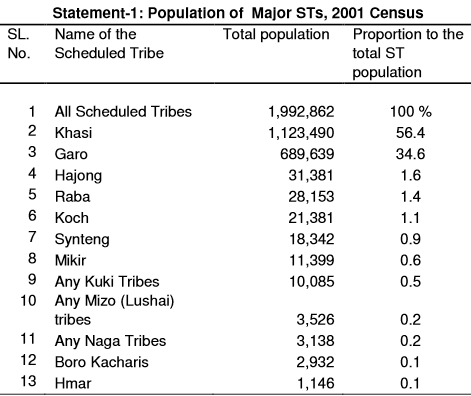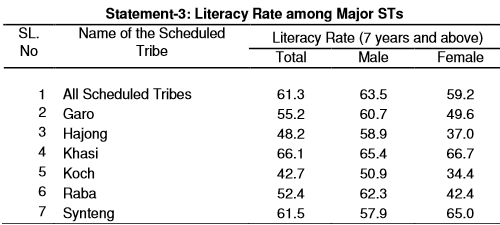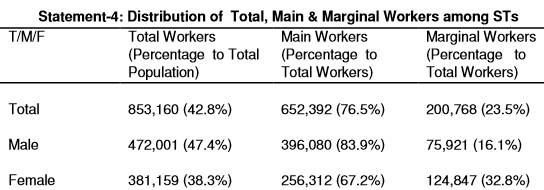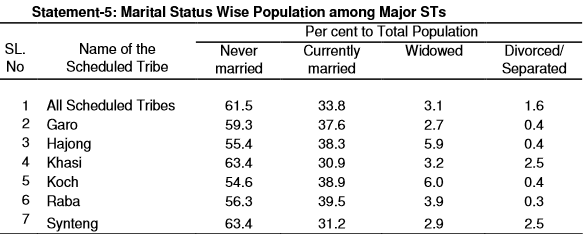Meghalaya
This is a collection of articles archived for the excellence of their content. Readers will be able to edit existing articles and post new articles directly |
Contents |
The source of this article
INDIA 2012
A REFERENCE ANNUAL
Compiled by
RESEARCH, REFERENCE AND TRAINING DIVISION
PUBLICATIONS DIVISION
MINISTRY OF INFORMATION AND BROADCASTING
GOVERNMENT OF INDIA
Meghalaya
Area : 22,429 sq km
Population : 29,64,007 (Prov. 2011 Census)
Capital : Shillong
Principal Languages : Khasi, Garo and English
HISTORY AND GEOGRAPHY
Meghalaya was created as an autonomous State within the State of Assam on 2 April 1970. The full-fledged State of Meghalaya came into existence on 21 January 1972. It is bounded on the north and east by Assam and on the south and west by Bangladesh. Meghalaya literally means ‘the Abode of Clouds’ and is essentially a hilly State. It is predominately inhabited by the Khasis, the Jaintias and the Garos tribe communities. The Khasi Hills and Jaintia Hills which form the central and eastern part of Meghalaya form an imposing plateau with rolling grassland, hills and river valleys. The southern face of the plateau is marked by deep gorges and abrupt slopes, at the foot of which, a narrow strip of plain land runs along the international border with Bangladesh.
AGRICULTURE
Meghalaya is basically an agricultural State in which about 81 per cent of its population depends primarily on agriculture for their livelihood. The State has a vast potential for development of horticulture due to the agro-climatic variations, which offer much scope for cultivation of temperate, sub-tropical and tropical fruits and vegetables.
Besides major food crops of rice and maize, Meghalaya is renowned for its orange (Khasi Mandarian), pineapples, bananas, jackfruit, temperate fruits like plum, pear and peach, etc. Cash crops, popularly and traditionally cultivated include potato, turmeric, ginger, black pepper, arcanut, bedeviling, tapioca, short staple cotton, jute and mesta, mustard and rapeseed. Special emphasis is presently being laid on non-traditional crops like oilseeds (groundnut, soyabean and sunflower), cashewnut, strawberry, tea and coffee, mushroom, medicinal plants, orchids and commercial flowers.
INDUSTRIES
The Meghalaya Industrial Development Corporation Limited, as the Industrial and Financial Institution of the State, has been rendering financial assistance to the local entrepreneurs. District Industries Centres have been working in the field for the promotion and development of small-scale, village, tiny and cottage industries. A number of industrial projects have been set up for the manufacture of iron and steel materials, cement and other industrial products.
FESTIVALS
A five-day-long religious festival of the Khasis ‘Ka Pamblang Nongkrem’ popularly known as ‘Nongkrem dance’ is annually held at Smit village, 11 km from Shillong. ‘Shad Sukmynsiem’, another important festival of the Khasis is held at Shillong during the second week of April. ‘Behdeinkhlam’, the most important and colourful festival of the Jaintias is celebrated annually at Jowai in Jaintia Hills in July. ‘Wangala festival’ is observed for a week to honour Saljong (Sungod) of the Garos during October – November.
TOURIST CENTRES
Meghalaya is dotted with a number of lovely tourist spots where nature unveils herself in all her glory. Shillong, the capital city, has a number of beautiful spots. A few of them are Ward’s Lake, Lady Hydari Park, Polo Ground, Mini Zoo, Elephant Falls, Shillong Peak overlooking the city and the Golf Course which is one of the best in the country.
TRANSPORT
Roads: Six national highways pass through Meghalaya for a distance of 606 kilometer.
Aviation: The only airport in the State at Umroi, is 35 km from Shillong.
GOVERNMENT
Governor : Shri Ranjit Shekhar Mooshahary
Chief Secretary : Shri W.M.S. Pariat
Chief Minister : Dr. Mukul Sangma
Jurisdiction of : Falls under the jurisdiction of High Court Guwahati High Court. There is a High Court Bench at Shillong.
AREA, POPULATION AND HEADQUARTERS OF DISTRICTS
District Area (sq km) Population Headquarters (Provisional Census-2011)
East Khasi Hills 2,748 8,24,059 Shillong
West Khasi Hills 5,247 3,85,601 Nongstoin
Ri-Bhoi 2,448 2,58,380 Nongpoh
Jaintia Hills 3,819 3,92,852 Jowai
East Garo Hills 2,603 3,17,618 Williamnagar
West Garo Hills 3,677 6,42,923 Tura
South Garo Hills 1,187 1,42,574 Baghmara
Wildlife parks and sanctuaries: India
LIVING ADVENTUROUSLY
HANG GLIDING/PARA GLIDING
Picturesque Shillong in Meghalaya with its beautiful landscapes is an ideal ground for aero sports, particularly gliding (hang/para gliding).
TREKS
There has been an increased interest in the many caves located in Meghalaya. There are said to as many as 200 caves which are yet to be mapped or explored. The surveyed caves include five which are the largest in the Indian subcontinent. Major caves are located in the Khasi hills, Jantia hills, South Garo hills.
Meghalaya : The Scheduled Tribes Census of India 2001
Meghalaya is predominantly a tribal state. The popula tion of Meghalaya at 2001 Census has been 2,318,822. Of these 1,992,862 persons are Scheduled Tribes (STs), which constitute 85.9 per cent of the state’s total popul ation. The state has registered 31.3 per cent decadal growth of ST population in 1991 -2001. There are total seventeen (17) notified STs in the state, and all of them have been enumerated in 2001 Census.
Population: Size & Distribution
2.Individual ST wise, Khasi constitute more than half of the total ST population of the state (56.4 per cent). Garo is second with 34.6 per cent. They together constitute 91 per cent of the total ST population. Synteng is listed both as a sub-tribe under Khasi and also as a separate ST. In 2001 Census, 18,342 population of Synteng has been enumerated separately, which constitute 0.9 per cent of total STs. The Hajong (1.6 per cent), Raba (1.4 per cent), and Koch (1.1 per cent) have sizable population in the state, each representing above one per cent of the state’s tot al ST population. The rest of the STs are very small in their population size. Of these, five STs namely Man (Tai speaking), Dimasa, Chakma, Pawi, and Lakher are having population between 617 to 10 only (Statement-1).
3.The STs in Meghalaya are predominantly rural (84.4 per cent). Individual ST wise, Koch are overwhelmingly confined to rural areas ( 97.2 per cent), followed by Raba (92.6 per cent), Hajong (91.4 per cent), and Garo (88.7 per cent). On the contrary, higher urban population has been registered among Synteng ( 28.2 per cent) and Khasi (18.6 per cent).
4.Of the seven districts of Meghalaya, in four the ST p opulation constitutes more than 95 per cent. East Khasi Hills has recorded the lowest at 77.5 per cent. This district, however, shares the highest 25.7 per cent of the total ST population of the state, Statement-2.
Sex Ratio
5.The matrilineal Meghalaya has recorded an even distribution of male and female population. Of the total ST population 996,5 67 have been returned as males and 996,295 as females. Individual ST wise, Synteng (1024) and Khasi (1017) have recorded sex ratio higher than 1000 mark. Although Garo have r ecorded comparatively low sex ratio (979) in the state, their sex ratio, however, is better than the aggregated national average for STs (978).
6.The child sex ratio (0-6 age group) of 974 for STs in the state is higher than the national average (973) for the corresponding populati on. Hajong (1003), Synteng (980), and Khasi (979) have registered child sex ratio above the state average (974). Quite contrary to the overall situation in the state, the c hild sex ratio is low among Raba (923). Literacy & Educational Level
7.The literacy rate among the STs in Meghalaya is 61.3 per cent, which is above the national average for STs (47.1 per cent). With 635 per cent male and 59.2 per cent female literacy rate, the ST women in the state are q uite at per with their male counterparts.
8.Khasi have registered the highest 66.1 per cent literacy rate among the six major STs in the state. Literacy rate is the lowest among Koch (42.7 per cent), closely followed by Hajong (48.2 per cent). It is significant t hat among Khasi and Synteng, the females are better off in literacy status. On the cont rary with 58.9 per cent male and 37 per cent female literacy, the Hajong women are lagging behind by as much as 22 per cent points. Significant gender gap in literacy has also been recorded among Raba, Koch, and Garo, Statement-3.
9.Merely 54.9 per cent of the ST population in the a ge group 5-14 years – the category of potential students – has been attending schools or any other educational institutions. Khasi have registered the highest 61.5 per cent, closely followed by Synteng (55.3 per cent) and Hajong (50.7 per cent). On the o ther hand Koch have recorded the lowest at 44.3 per cent. Less than half of the populati on among Garo (45 per cent) and Raba (47.8 per cent) are attending schools in this age group. 10.Of the total ST literates, 3.3 per cent are having educational level graduate and above. Synteng (4.6 per cent) and Khasi (4.4 per cent) are well ahead, among the six major STs in the state, with more than four per cent o f their literate population having this educational status. Rabha, Koch, and Hajong are compara tively lagging behind with one per cent of their literates having this level of educa tion.
Work Participation Rate (WPR)
11.In 2001 Census, 42.8 per cent of the ST population has been recorded as workers, which is below the aggregated national figure for STs (49.1 per cent). Of the total workers 76.5 per cent have been recorded as main workers and 23.5 per cent as marginal workers. WPR at 38.3 per cent among female is lower than male (47.4 per cent). In Meghalaya, the ST women are rather close to their male counterparts with 83.9 per cent male and 67.2 per cent female as main workers, Statement-4.
12.With regards to WPR there is not much variation am ong the different STs. The highest WPR of 46.5 per cent has been registered among Raba, while it is the lowest among Synteng (41.7 per cent). The Khasi and Hajong b oth have an identical WPR at 41.8 per cent. The gender gap in work participation is quite significant among Hajong (male 50.1 per cent, female 33.3 per cent) and Koch (m ale 52.5 per cent, female 37.5 per cent), while it is the lowest among Garo (male 47.7 per cent, female 40.2 per cent).
Category of Workers
13.Of the total ST main workers, 56.2 per cent have been registered as cultivators and another 13.1 per cent as agricultural labourers. 289 per cent have been returned as ‘other workers’ and the remaining 1.8 per cent in the household industry category.
14.The highest 70.7 per cent cultivators have been reco rded among Raba, followed by Garo (67.4 per cent), Khasi (49.5 per cent), and Koch (49.2 per cent). On the other hand the percentage of cultivators is the lowest among Hajong (35.5 per cent). A substantial number of Hajong main workers have, however, been recorded as agricultural labourers (18.8 per cent). Koch have recorded the highe st 21.5 per cent agricultural labourers as main workers.
Marital Status
15.As regards marital status, 61.5 per cent of the popul ation is never married, 33.8 per cent currently married, 3.1 per cent widowed, and merely 1.6 per cent divorced /separated. It is significant to note a very high of 2. 5 per cent population among Khasi and Synteng has been recorded as divorced/separated (St atement-5).
16.Merely 1.5 per cent of the ST female population b elow 18 years – the minimum legal age for marriage – has been recorded as ever mar ried. Of the six major STs, the Synteng has recorded the highest at 1.8 per cent, whi le Khasi the lowest at 1.4 per cent.
17.The ever married males below 21 years – the minimu m legal age for marriage – constitute only 1.3 per cent of the total ST populat ion of this age category. The Synteng has recorded the highest at 1.5 per cent among the six major STs, while it is the lowest (1.1 Per cent) among Hajong.
Religion
18.Of the total ST population majority 79.8 per cent are Christians and 5.9 per cent Hindus. A substantial number of ST population (13. 2 Per cent) have been recorded under “Other religions and persuasions”. Quite a large number (6,324 persons) did not mention their faith, and they have been categorized under “Religion not stated”. Besides, 13,105 persons have been recorded as Muslims and 2,249 as Budhists constituting 0.7 per cent and 0.1 per cent respectively.
Garo hills
2015: HC directs AFSPA imposition
The Times of India, Nov 05 2015
Manosh Das
Meghalaya HC asks Centre to impose AFSPA in Garo Hills
The Meghalaya high court's directive on Monday asking the Centre to consider imposing the controversial Armed Forces (Special Powers) Act, 1958, in insurgency-ravaged Garo Hills has hit the state where it hurts most. The move comes amidst prolonged movements for the repeal of the act from the northeast which have rocked the region's states, especially Manipur, over the years.
The high court cited rising cases of kidnappings and killings by militant groups in the Garo Hills in its order.
“Recently , a central intelligence officer and a trader who had been kidnapped for ransom were killed by insurgents. According to data supplied by Meghalaya Police, Garo insurgents abducted 25 civilians, 27 businessmen, 25 private sector employees, five government employees and five teachers between January and October 31 this year,“ a police officer said.
“This court... cannot remain a mute spectator and shy away from its constitutional obligation to protect the fundamental rights guaranteed by Part III of the Constitution in general and Article 21 in particular,“ the full bench of the Meghalaya HC observed in its ruling. The HC directed the Union home secretary and defence secretary to ensure compliance by placing the order before the Centre.




